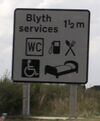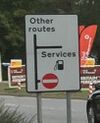Criteria For Inclusion
This page aims to clear up some of the mystique around how we decide which pages to include. It can then serve as a reference guide when encountering new anomalies.
Unfortunately, these things are never as simple as black-and-white, and a degree of judgement is always needed. But this is a good start.
Adding and Removing Information
We need to remember that some people are reading this website while sat in their car, or about to begin their journey, while others are planning a journey they'll be making next week.
A good guide is to use the "7 days rule". This means if a change is going to be in place for less than 7 days, it probably isn't worth updating the website. The "|warning" variable that all facilities have can be a useful way of explaining that a facility has unusual opening hours.
New facilities must only be added when it clearly won't cause any confusion. A new restaurant can be added the evening before, because nobody would expect it to be open at night anyway. Whereas a new service area should only be added a few hours early. Old facilities should be removed before they could possibly cause confusion, removing them early if necessary.
If a service area closes temporarily, assuming it will be closed long enough that updating it won't cause too much confusion, it should remain "closed" until it is actively working to reopen. Then, it can become "planned".
The Services Test


When dealing with service areas, the rules are as follows:
- Rule A: if it has signs to Diagram 2919.2 or Diagram 2313.1, or something very similar, it automatically gets a page. Even if those signs are a mistake, like at Redwings, it still counts because those errors are interesting.
- A1: If it's signed from a motorway, that motorway gets its own page, like M1. A-roads don't automatically get a page, as there are thousands of A-roads and most of them aren't very busy. Busy A-roads get their own category, and very busy A-roads get their own page.
- A2: If it's signed from a motorway, we treat it as a motorway site. If it's not, we treat it as primary or non primary, depending on the road that it's on.
- For info: motorway pages like M1 will ignore primary/non primary services like Markfield. However, the search engine will still see that it's on the M1. A-road pages like A1 will recognise all classes.
- Rule B: if it doesn't quite pass Rule A, but it does get some-sort of mention from the road AND we have covered that road already, then it is probably worth creating a page anyway. Example: Teddington Hands.
- This is because most readers won't understand Rule A, and if we are promising a list of all the "Services" on the A46, it's churlish to leave one out because "it doesn't say Services the right way".
- Services added under Rule B (or C or D) don't get included in How Many, or on most brand lists.
- Rule C: if it doesn't have any official road signs at all, then it won't appear on pages like M1 or A46. If it's on a road we don't already cover then that doesn't matter. Either way, it may still appear in the website's search engine, and in direct searches. First we need to ask: are people looking for it?
- C1: If it's on a road that we already cover, then that counts in its favour. There's not much point adding a new road that doesn't even have any qualifying services.
- C2: If it has parking areas for all vehicles, then that counts in its favour, because most people would call that a service area. Ideally that should include free parking even for non-customers.
- C3: If it has several different branded facilities, then that counts in its favour. This should include fuel and somewhere with free toilets.
- C4: If lots of people are talking about it, it may be worth us including it. Google Trends, Twitter and Geograph can be helpful for that.
- C5: If people keep calling it "Services", then that counts in its favour.
- C6: If it appears in a popular commercial map, then that counts in its favour. We use Ordnance Survey as the acid test.
- Rule D: if none of the above apply, but it's still interesting, then it can be added. Examples include Dover Port (which has been owned by three different motorway names) and Wansford (which is a famous roadside landmark).
- We take "interesting" to mean "having contributed to the history of roadside facilities", that being the subject which we have written so much about.
Technically, we have pretty much unlimited space, so you'd think we could add hundreds more petrol stations. This comes with a catch: once we add them, we've got to keep them up-to-date. Just because someone has lots of spare time today, doesn't mean they'll have lots of spare time next year!
As a result we have to ensure that this website is not unmanageable, and we do that by prioritising the pages that are most useful to people.
The Exceptions
We are only interested in places which are there to serve passing traffic. There are examples of "Services" on private land (or similar), such as at the exit from the short stay car park at Gatwick Airport South Terminal, where it is only really used by people already visiting the airport. There's no point adding places like that. These are called "generic description of a facility".
Similarly we aren't trying to list every retail park, food van, business park or town centre. We only want the ones which really do match one of the conditions above.
Places which may just about match one of the criteria above but haven't yet convinced us that they warrant full inclusion are documented at MSO:Services we don't list. That is the place to go for all your controversy and debate!
EV Hubs
The government started formally using the term "EV hub" in 2025. As we don't yet know exactly how they will define it, we can't have a policy on it.
The suggestion is that EV hubs should have advance signage from 1 mile away, in which case we would expect to list them, as they are an obvious step forward from "Services". In reality, there are likely to be many sites with no advance signage, and existing sites with made-up signage, so we will need to see a few in action before we can confirm our position.
Brands
See also: Help:Style guide
We write about brand names that have appeared at "Rule A" service areas, why they were added, what they do, and how they've changed. This includes old-fashioned, company-owned brand names.
We don't need any more empty pages! If there's nothing to say, it's not worth creating a page, and instead the brand can have a fleeting reference on another page. Generally we only talk about each brand with reference to "Rule A" service areas, but exceptions are made for brands strongly associated with roadside dining, like Happy Eater.
Brand names should be clearly visible and promoted to the public. Fuel types, charging point brands, game arcade machines, vending machines, payment systems, hand dryers and slogans don't count, unless there really is a lot of relevant things to say about them.
Templates
Brand name templates allow the search engine to find each branch. They also power maps like Map:KFC.
We used to have a rule that these templates could only be created if they are really needed, otherwise they clutter up the search engine. Thanks to Category:Hide From Drop-Down, this is no longer a problem, and you can now create as many templates as you like! Just make sure they go in that category, and they are deleted if they are empty.
Sometimes we like to show off by displaying the brand name exactly as it's written, for example Waitrose or Little Waitrose. It's important that the search engine knows that they are effectively the same thing, and that Template:Little Waitrose is just another way of running Template:Waitrose, rather than a whole new creation.